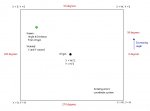PhoenixRider
New Member
I have been playing around with a 40x1 Pickaxe and a LCD screen and a servo-mounted Sharp IR distance sensor and an IR Beacon detector and with Hippy's excellent Pickaxe <=> PC serial comms program and Visual Basic I have it all displaying on a radar-like display and in general, keeping myself quite well entertained (and my wife quite impressed).
With the help of this forum, that is. A lot of help. I was convinced I had fried my first Pickaxe! How embarrassing. Order another chip WITH resonator this time. Turns out the 28x1 DOES need the resonator. The chip WORKS! I feel better. Now what do I do with a spare chip - hey I2C - and I got that EEPROM ... and I NEED some of those HopeRF units. If only those guys would finish up the research & testing and help a couple of newbies through the process ...
Each step of the way I was thankful I could search this forum. I am so impressed with the level of expertise and general helpfulness exibited by so many. OK, gush over. Because now I have to step out and ask:
What are the factors that affect the noise level of motors, gearboxes and servos? And anything else I missed?
I purchased a small cheap Tamiya robot kit intending to mount the IR systems and take the show on the road but it was quite slow & noisy. I spent a bit more for a better kit from OWL but it was only marginally better.
My wife has been very ill for several years and has become extremely sensitive to any noise and while she really does enjoy my hobby (well, as much as any wife enjoys her husband's hobby), she really cannot stand that much noise.
Rather than keep trying I thought I would ask the overnight global brain trust
And Hippy, it would seem to me that I am not the first to want to display polar coordinate data in VB. Seems like a waste to convert to pixels or twips or pips and process it that way. Then when I want to rotate the data because the robot turned it is really complicated in screen coordinates when it would be so simple in polar coordinates. I would like to think that someone smarter than me has already addressed this issue and I just don't know enough to phrase the search. Maybe an object with an internal polar coordinate convention?
Thanks
With the help of this forum, that is. A lot of help. I was convinced I had fried my first Pickaxe! How embarrassing. Order another chip WITH resonator this time. Turns out the 28x1 DOES need the resonator. The chip WORKS! I feel better. Now what do I do with a spare chip - hey I2C - and I got that EEPROM ... and I NEED some of those HopeRF units. If only those guys would finish up the research & testing and help a couple of newbies through the process ...
Each step of the way I was thankful I could search this forum. I am so impressed with the level of expertise and general helpfulness exibited by so many. OK, gush over. Because now I have to step out and ask:
What are the factors that affect the noise level of motors, gearboxes and servos? And anything else I missed?
I purchased a small cheap Tamiya robot kit intending to mount the IR systems and take the show on the road but it was quite slow & noisy. I spent a bit more for a better kit from OWL but it was only marginally better.
My wife has been very ill for several years and has become extremely sensitive to any noise and while she really does enjoy my hobby (well, as much as any wife enjoys her husband's hobby), she really cannot stand that much noise.
Rather than keep trying I thought I would ask the overnight global brain trust
And Hippy, it would seem to me that I am not the first to want to display polar coordinate data in VB. Seems like a waste to convert to pixels or twips or pips and process it that way. Then when I want to rotate the data because the robot turned it is really complicated in screen coordinates when it would be so simple in polar coordinates. I would like to think that someone smarter than me has already addressed this issue and I just don't know enough to phrase the search. Maybe an object with an internal polar coordinate convention?
Thanks

